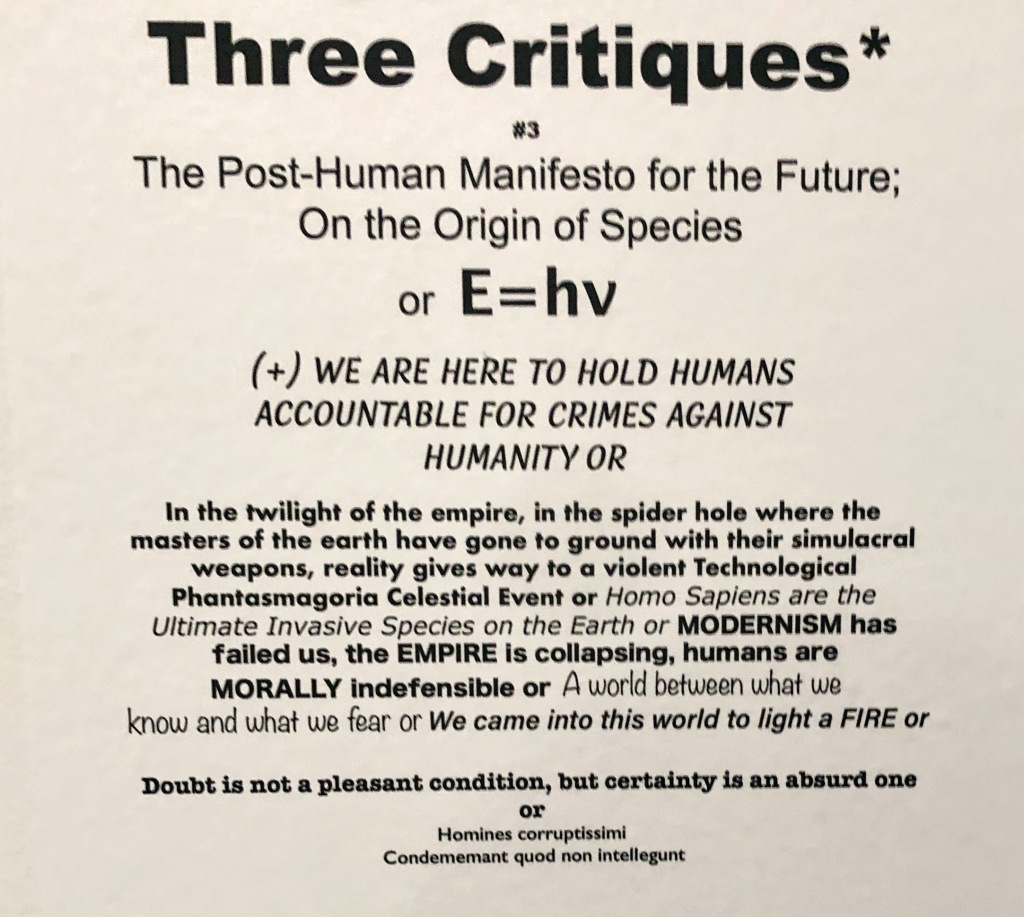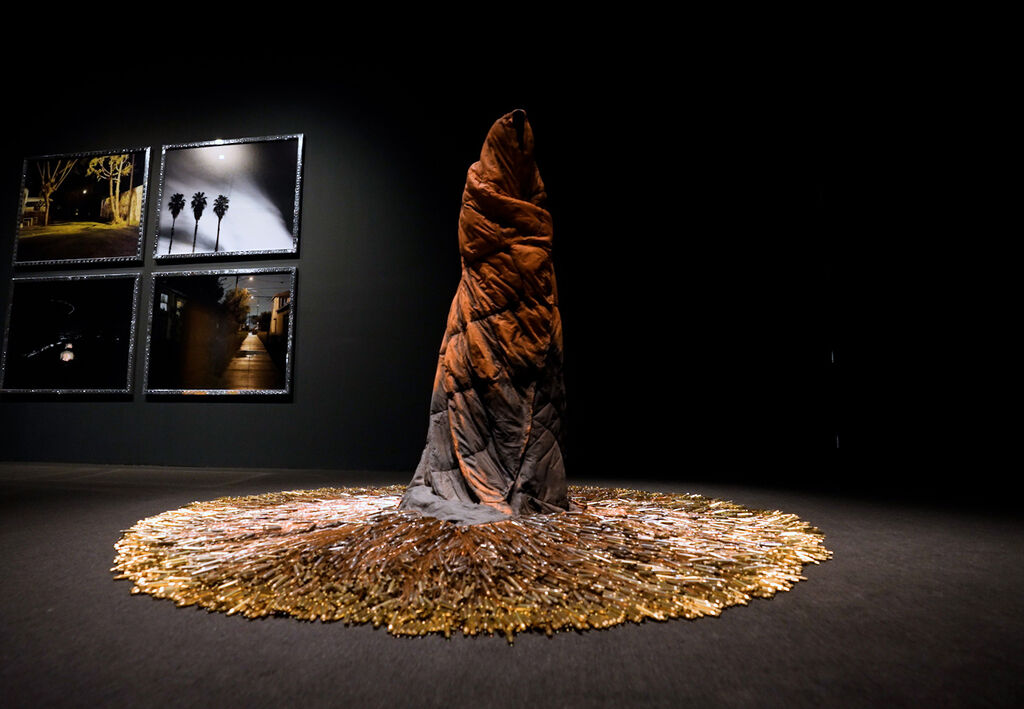So many of the people I encountered in New York last week had an edge of resentment and anxiety. The desperate days of the pandemic barely receding, the present dominated by spiraling inflation and violence at home and abroad, and the future — the future — looming as a terrifying mix of extremist, political mayhem and climate meltdown.
It made sense to visit the dark, deathy 911 Memorial, with its relentless flow of tumbling water into the black pit of eternity. What did that terrible event — now so distant — foreshadow?

Quiet As It’s Kept – The Whitney Biennial
(I don’t quite get the title? “Quiet As It’s Kept” is referred to, in the materials about the show, as an expression, but it’s one I had not heard before.)
At the 2022 Whitney Biennial — the eightieth edition — that same feeling of future dread that was conjured by the 911 Memorial was in evidence. A mix of trauma, fear and pain was defnitely one of the thematic strands running through the massive exhibition.
The work of Daniel Joseph Martinez, for instance, made me think of the Flagellants of the middle ages, who “demonstrated their religious fervor and sought atonement for their sins by vigorously whipping themselves in public displays of penance.”
Below is the Post-Human Manifesto presented by Daniel Joseph Martinez:

Daniel Joseph Martinez is an artist who works in many different media, including modifying his own body in monstrous ways. So much loathing, rage and frustration seems to be contained in this work. He describes his piece at the Whitney as a:
“radical performative experiment of becoming post-human and the evolution of a new species.”
Daniel Jospeh Martinez


Similarly, a video installation by Andrew Roberts called The Horde, displays creatures that are him, but not him. They are horrible — undead things — that he identifies with “as a Latino and queer person confronted by a crossfire geopolitical war where bodies and identities similar to mine are treated as disposable.”
A sculpture by Canada’s own Rebecca Belmore, of a human figure or maybe a sort of grim reaper wrapped in a sleeping bag, fleeing or hiding or in mourning, had a powerful feeling of despair. It was surrounded by a glittering array of gold coloured bullet casings and stood in the murky light of a gallery with walls painted black.

“I’m hoping that the work contains some positive aspects of this idea that we need to try to deal with violence,” is a quote from Belmore in the Biennial notes.
Photographs by Buck Ellison confront violence from a circuitous distance. For me, the result was a lurid fascination.

Buck Ellison hires models and builds sets for his photographs, attempting to recreate particular moments in the lives of the very rich and priviledged. Here, Eric Prince is depicted, at his ranch in 2003, just before he received notoriety and billions of dollars for his role as the founder of Blackwater, the military contractor which figured so prominently in the war in Iraq.
Buck Ellison has stated that he tries to change the predictable narrative and force the viewer to confront their own emphathy or curiousity. (It kind of works … and then there is the fact that the model bears an uncanny resemblance to a close relative of mine.)

This show has many moments of emotional power but one of the most dramatic was by artist Coco Fusco. It was a riveting experience, watching her 12 minute video essay, recorded in the waters around Hart Island, home to the largest mass grave in the United States, where New York’s unclaimed victims of COVID-19 have been buried.

Yes, there was painting.
In fact, it seemed like there is a resurgence of abstract painting. It is definitely great to look. The huge, somehow claustrophic paintings by Denyse Thomasos, another Canadian woman, are hectic, compulsive, bristling with energy.

Denyse Thomasos, who died in 2012, stated that her paintings “refer to the violent systems and structures that shape our world,” and that “…the paintings are deeply personal.”
The painting below is by Awilda Sterling-Duprey and it’s called “…blindfolded” because … well … watch the video.

I was really happy to see the paintings by Jane Dickson, one of the artists I remember from the East Village Art Scene of the early eighties. Her canvases looked so lush and rich in form and content.

63 artists and collectives are participating in the eightieth Whitney Biennial. This is just a handful of the items that caught my eye on that sultry afternoon.
Often, there is some sort of controversey roiling the bi-annual exhibition at this particular museum, but this year there was none, that I could discern … yet.
- 2019 – boycotted by a group of artists, in protest of the museum’s vice chairman, Warren Kanders. Warrren Kanders’ companies sell military supplies (teargas and bullets) via Safariland.
- 2017 – In response to the exhibition a painting by Dana Schutz, depicting Emmet Till in an open casket, African-American artist Parker Bright began to silently protest it by standing in front of the painting wearing a T-shirt with “Black Death Spectacle” on the back.
- 2014 – The YAMS Collective, or HOWDOYOUSAYYAMINAFRICAN?, a collective of 38 mostly black and queer artists, writers, composers, academics, filmmakers and performers participated and withdrew from the 2014 Biennial as a protest of the Whitney Museum’s policies including a lack of diversity.
- 1987 – the show was protested by the Guerrilla Girls for its alleged sexism and racism.
- 1976 – artists protested what was viewed as blatant economic pandering because the Biennial’s 1976 theme revolved around bodybuilding as art and featured California’s future governor Arnold Schwarzenegger.

Enjoyed reading your blog sounded like the Show was prescient . Let me guess : Eric Prince lookalike ? The Mountie ! Right ? Xo R
Sent from my iPhone
>
LOL…close!